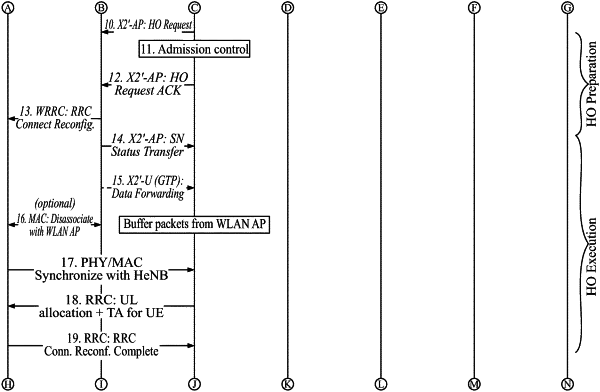| CPC H04W 36/0066 (2013.01) [H04B 17/382 (2015.01); H04L 1/1657 (2013.01); H04W 28/0252 (2013.01); H04W 36/0005 (2013.01); H04W 72/231 (2023.01); H04W 76/11 (2018.02); H04L 5/0053 (2013.01); H04W 52/0203 (2013.01); H04W 52/14 (2013.01); H04W 72/12 (2013.01); H04W 74/004 (2013.01); H04W 74/006 (2013.01); H04W 84/02 (2013.01); H04W 84/042 (2013.01); H04W 84/12 (2013.01); H04W 88/06 (2013.01); H04W 88/08 (2013.01); H04W 92/20 (2013.01)] | 20 Claims |

|
1. A cellular network access node, comprising:
one or more computing processors; and
computing memory communicatively coupled with the one or more computing processors, the computing memory having stored therein executable computing instructions that upon execution cause the cellular network access node to perform operations comprising:
transmitting, to a wireless local area network (WLAN) access node using an extended X2 interface, a first request to setup communication between the cellular network access node and the WLAN access node;
receiving, from the WLAN access node a response to the first request to setup the communication;
using the setup communication, transmit to the WLAN access node using the extended X2 interface, a second request for information regarding a load associated with the WLAN access node;
using the setup communication, receive from the WLAN access node using the extended X2 interface the information regarding the load associated with the WLAN access node;
transmitting a third request with management information to the WLAN access node, wherein the management information comprises information associated with the management of one or more bearers;
receiving an acknowledgement message associated with the third request from the WLAN access node;
based on the acknowledgement associated with the third request, transmitting a radio resource control reconfiguration message to a UE, wherein the radio resource control reconfiguration message comprises new WLAN configuration information, a WLAN access point (AP) ID, and information to configure the UE's security on WLAN AP connection; and
communicating downlink data from the cellular network access node using the extended X2 interface to the WLAN access node, wherein the extended X2 interface is an interface for direct signaling and data exchange between the WLAN access node and the cellular network access node.
|